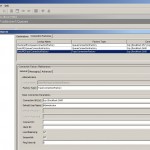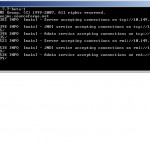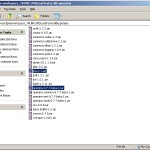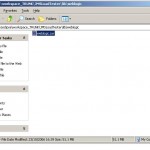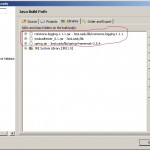JMS Load Tester is a small open source command line based Java (>1.6) application to load test JMS brokers like SonicMQ, ActiveMQ, OpenJMS, HornetQ and others.
It is configured using a properties file and should run under Windows and Un*x systems.
The tool can start multiple Threads (Listeners, Senders) that "penetrate" the JMS broker by sending and/or receiving loads of messages. That's already all - no magic at all. It can be configured with a property file and all the broker and destination lookup is done via JNDI. At the moment the tool handles everything as generic JMS "destination". It is not aware of the underlaying implementations like Queue or Topic. The destination lookup is also done via JNDI. Have a look at the Screenshots, the User Guide and the different property values which should give you a fairly good understanding of what this tool does and how it works.
Please let me know which features are missing, what does not work as expected or seems to be buggy.
just take the latest zip from the downloads and follow the setup instructions further down.
or clone the repository and build from scratch with maven
git clone git://github.com/niesfisch/jmsloadtester.git
cd jmsloadtester.git
mvn clean package
cd target/dist/jmsloadtester_xxx <----- here you will find the package application
chmod a+x jmsloadtester.sh
Apache 2.0 http://www.apache.org/licenses/LICENSE-2.0.txt
- download the zip file and extract it to any location you like.
- change into that directory
open the file conf/jndi.properties and use the JNDI provider settings that the app should use to lookup the connection factories and destinations. this is just to make sure the application can connect to a local or remote JNDI repository, nothing more.typical examples can be found in the conf/samples folder. have a look at the JNDI setup instructions of the provider you are using or ask you sysadmins for the connection details. the application is using this information to create the JNDI "InitialContext" and holds this for the rest of the runtime.
e.g. a typical SonicMQ setup
java.naming.provider.url=tcp://localhost:2506
java.naming.factory.initial=com.sonicsw.jndi.mfcontext.MFContextFactory
java.naming.security.principal=Administrator
java.naming.security.credentials=Administrator
-
open the file conf/app.properties and change the value for the property "javax.jms.ConnectionFactory" to the jms connection factory that should be used to create the sessions. this has to be available in the JNDI repository. a typical setup for SonicMQ topic/queue connection factory can be found here. the connection factory can be a topic or queue connection factory as long as it implements the javax.jms.ConnectionFactory interface.
-
close the files and save them
in order to use the application you have to place certain vendor jar files in the classpath, which are not part of JMS Load Tester itself. when the application is starting it is trying to connect to the JNDI repository you provided in the jndi.properties files. it then tries to get a javax.jms.ConnectionFactory object(instance) via JNDI. to get this working the JRE/JVM needs these provider specific implementations in the classpath. if they are not present you will get the infamous "ClassNotFoundException". consult the documentation of your JMS provider. the selected jar files in the following screenshots give you an idea:
- open the file jmsloadtester.bat (Windows) or jmsloadtester.sh (Un*x) and point the "YOUR_CP" to all the jars that should be included (i.e. the vendor jars we just talked about)
- look at the example lines starting with "set YOUR_CP=..." (Windows) or "YOUR_CP=..." (Un*x) and use them (delete the "REM" or "#") in front of them
- save the file and close it
- look at the more detailed explanation
now open the file app.properties again. its time to configure the actual load test.
change the the lines starting with "app.listener.*"
app.listener.thread.count=1
app.listener.wait.for.message.count=1
app.listener.listen.to.destination=name of your Topic or Queue, must be available in the JNDI repository
change the the lines starting and "app.sender.*"
app.sender.threads.to.start=1
app.sender.send.to.destination=name of your Topic or Queue, must be available in the JNDI repository
app.sender.message.content.strategy=STATIC#1#this is the test message
app.sender.pause.millis.between.send=0
setup how much output you want to see
app.output.debug.strategy=STDOUT
app.output.result.strategy=STDOUT
app.output.message.strategy=STDOUT
save and close all the open files. execute the "jmsloadtester.bat" or "jmsloadtester.sh". the application should be running, sending to and receiving from the destination you configured.
if everything is working then you can continue with doing some real load testing by changing the settings and "burning down" your JMS broker. Have a look at some useful settings to start with (further down). Try to watch the load on the broker and network in parallel.
... gives you an overview of what you can setup
tells the application what message content to send.
never delete the dividers ("#") in the line. the application needs them to split the settings.
e.g.
app.sender.message.content.strategy=STATIC#500#your message content
would tell each sending thread to send the message "your message content" 500 times. if you have 20 parallel threads running this would result in 500 * 20 = 1000 messages to be sent.
e.g.
app.sender.message.content.strategy=FOLDER#8#.*txt#c:/testmessages
folder looks like:
c:/testmessages
message1.txt
message2.txt
message4.jpg
message5.xml
message6.doc
message7.txt
would tell each thread to take every file ending with "txt" in the folder "c:/testmessages" and send it "8" times. if you have 20 parallel threads running this would result in 20 * 3 * 8 = 480 messages to be sent (only the .txt files and each one 8 times). this only works on the specified folder, not recursively. be careful when choosing the matcher for the files. it has to be provided in a Regular Expression format that Java understands. make sure you provide forward slashes "/" for directories. the following table lists some typical examples.
.* all files
.*.txt all files ending with .txt
.*message.* all files having the word "message" in the filename
123.text only the file "123.text"
^[\\d]+.text all files starting with at least one (+) digits (0-9), e.g. 123.text but not test123.text
use this description to get an overview of what the "matcher" can do. make sure you escape all "constructs" with a backslash. e.g. "\d" stands for all known digits, when you want to use it you have to put "\d" into the app.properties file, otherwise the application would search for a file with "\d" in the file name.
you are also able to put in certain placeholders. this works for STATIC and FOLDER (in each file that will be sent). the table below lists the allowed placeholders. each placeholder has to be surrounded by colons ":"
nanotime outputs the nanotime (timestamp) when the message was generated, e.g. 1322952392731831
datetime outputs the date and time when the message was generated, e.g. Tue May 13 17:33:36 BST 2008
random outputs a random number (uses java.util.Random.nextLong()), e.g. -2893472384729384 or 39483983349
e.g.
app.sender.message.content.strategy=STATIC#1#this is the test message :datetime: :nanotime:
the resulting text in the message should look something like:
this is the test message Tue May 13 17:43:07 BST 2008 1322952392731831
defines where the output should go. if you don't want to see every detail about the running application then it makes sense to set every output to "SILENT". this leaves you with only the most important information beeing printed. be careful when you use the FILE output. this will slow down the performance as the application has to handle the file access. try the various settings and see how much is "useful" for you. turn everything on (STDOUT) if you are using the application for the first time, as you should know how this tool works. you are free to choose any of the settings for each strategy.
STDOUT prints to standard out (STDOUT)
STDERR prints to standard error (STDERR)
SILENT prints nothing
FILE# prints to the specified file, make sure you have the hash "#" after FILE
e.g.
app.output.debug.strategy=STDERR
app.output.result.strategy=FILE#c:/results/results.txt
app.output.message.strategy=STDOUT
or
app.output.debug.strategy=FILE#c:/results/debug.txt
app.output.result.strategy=FILE#c:/results/results.txt
app.output.message.strategy=FILE#c:/results/messages.txt
or
app.output.debug.strategy=SILENT
app.output.result.strategy=SILENT
app.output.message.strategy=SILENT
the application is shipped without the provider specific jars holding the JMS implementation. that's why you have to provide them, i.e. point to them, in the .bat file. the application then knows where to find them. to do so open the "jmsloadtester.bat" or "jmsloadtester.sh" with an editor and append one or multiple "set YOUR_CP" lines (after the "REM your classpath with the jar files goes here !!").
OpenJMS example
...
set OPENJMS_LIBS=D:\dev\eclipse\workspace_TRUNK\JMSLoadTester\lib\openjms\
set OPENJMS_CLASSPATH=%OPENJMS_LIBS%\openjms-0.7.7-beta-1.jar;%OPENJMS_LIBS%\jms-1.1.jar
...
set YOUR_CP=%OPENJMS_CLASSPATH%
....
would tell the application to load the two OpenJMS specific jar files "openjms-0.7.7-beta-1.jar" and "jms-1.1.jar" when the application is starting up. have a look at the samples in the "bat" or "sh" file. to figure out which jar files you need consult the documentation of your broker. a not so perfect solution would be to include all jar files from the lib directory of your JMS broker (remember: "not so perfect" ;-)). make sure that you include the "%YOUR_CP%" in each line you add after the first line. e.g.
...
set YOUR_LIBS=D:\providerA\libs\
set YOUR_CLASSPATH=%YOUR_LIBS%\a.jar;%YOUR_LIBS%\b.jar;%YOUR_LIBS%\c.jar;%YOUR_LIBS%\d.jar;
...
set YOUR_CP=%YOUR_CLASSPATH%
....
i think you got the idea ;-)
in order to load test a JMS broker it makes sens to try different settings, e.g. the senders that are started, how many messages they should send, the pause they should do between each send and so on. the following settings should give you an idea of how to start. i would start by only sending messages, i.e. set the listeners to 0 and try different sender counts
# listener setup
app.listener.thread.count=0
# sender setup
app.sender.threads.to.start=10
app.sender.message.content.strategy=STATIC#100#test message :datetime: :random: :nanotime:
app.sender.pause.millis.between.send=0
will send 10 * 100 = 1000 messages to the broker
# sender setup
app.sender.threads.to.start=40
app.sender.message.content.strategy=STATIC#1000#test message :datetime: :random: :nanotime:
app.sender.pause.millis.between.send=0
will send 40 * 1000 = 40000 messages to the broker
# sender setup
app.sender.threads.to.start=80
app.sender.message.content.strategy=STATIC#1000#test message :datetime: :random: :nanotime:
app.sender.pause.millis.between.send=0
will send 80 * 1000 = 80000 messages to the broker
now it's time for some real action
# sender setup
app.sender.threads.to.start=1000
app.sender.message.content.strategy=STATIC#1000#test message :datetime: :random: :nanotime:
app.sender.pause.millis.between.send=0
will send 1000 * 1000 = 1000000 messages to the broker
set all the output strategies to "SILENT" to get maximum performance. on my machine i get a "heap space out of memory" exceptions or the broker loses it's connections and so on when i reach a certain limit. that's why it is is a load test tool at all :)
at the moment JMS Load Tester is starting as many threads as you have defined in the app.properties file. it depends on the speed of the local JVM running the application how fast everything will be. it does not wait until all threads have started up and then sends all the messages. each started thread sends it's messages as soon as it has started. so no "synchronous" "fire-now" thing. on a slow machine with litte RAM you won't get the same performance as on a fast machine with lots of RAM. with less RAM you are likely to get "HeapSpaceOutOfMemory" exceptions.
when you define listeners and senders for the same destination then you should see that messages sent arrive back in the application because they share the same destination. some typical scenarios (we assume the same destination is set):
| count | messages | total | |
|---|---|---|---|
| senders | 10 | 100 | 1000 |
| listeners | 10 | 100 | 1000 |
| result | 1000 messages should have been sent and received on the same destination. the program exits and prints the result. | ||
| senders | 20 | 500 | 10000 |
| listeners | 500 | 20 | 10000 |
| result | 10000 messages should have been sent and received on the same destination. the program exits and prints the result. | ||
| senders | 100 | 40 | 4000 |
| listeners | 1 | 1000 | 1000 |
| result | 4000 messages should have been sent. 4000 should have been received, even if only 1000 were expected. the program exits and prints the result. | ||
| senders | 70 | 100 | 7000 |
| listeners | 70 | 1000 | 70000 |
| result | 7000 messages should have been sent. 7000 of 70000 expected should have been received. the program will wait until all of the 70000 expected messages are received. | ||
| senders | 60 | 10000 | 600000 |
| listeners | 1 | 1 | 1 |
| result | 600000 messages should have been sent. 600000 should have been received, even if only 1 was expected. the program exits and prints the result. | ||
| senders | 0 | 100 | 0 |
| listeners | 2 | 100 | 200 |
| result | 0 messages should have been sent. 0 of 200 expected should have been received (because nothing is sending). the program will wait until all of the 200 expected messages are received. | ||
| senders | 10 | 10 | 100 |
| listeners | 11 | 10 | 110 |
| result | 100 messages should have been sent. 100 of 110 expected should have been received. the program will wait until all of the 110 expected messages are received. | ||
| senders | 10 | 10 | 100 |
| listeners | 0 | 100 | 0 |
| result | 100 messages should have been sent. nothing is listening for incoming messages. the program exits and prints the result. | ||
listeners can receive more than they were waiting for as long as they get the messages they were waiting for based on the configuration.
follow these steps to overwrite the default session handler and call you own one (all the examples are illustrated based on eclipse)
- create a new eclipse project -> e.g. JmsLoady
- copy the "conf" and "lib" directories from the jms load tester distribution into the new projects root folder (see image)
- now open the project settings
- add all the jar files found in the libs directory to the "libraries" tab (see image)
- add the "conf" directory on the "source" tab (see image)
- now add all your necessary jms api libs to the classpath (like sonic jars, openmq etc.)
- open the "conf/app.properties" and "conf/jndi.properties" file and change to your appropriate values
- open the "run as" dialogue (see image)
- double click on "java application", enter "de.marcelsauer.jmsloadtester.Main" as main class in the "Main" tab
- open the "arguments" tab and add the line "-Dapp.properties.file=./conf/app.properties" to the "VM arguments" (see image)
- save and run the app
if everything is running then we can go ahead and actually create our own classes
- create a new package "samples" in src
- create a new class "TheSampleSessionHandler.java" which extends "AbstractThreadAwareSessionHandler" (take the sample one from the image)
- create two new classes "TheSampleInterceptor1" and "TheSampleInterceptor2" which implement "MessageInterceptor" (take the sample one from the image)
- now open the "conf/app.properties" and add/change the values (see image)
- build and run the application again
- check the console window for the "system.out.println" lines (see image) which prove that our new classes are used
you should now have an idea of how these "pluggable" features work and create some real stuff the rest is up to you :) feel free to contact me if something is wrong or unclear or you know a better way to do things.
just a short wrap up of how JMS Load Tester works
- Java > 1.6, purely based on Java interfaces, provider specific implementations are not bundled, they have to be provided by you (in form of "jar" files)
- all lookup and retrieving is done via JNDI (Factories, Queues, Topics)
- the application creates a Thread for each listener and sender (as configured in the app.properties)
- two central pieces keep track of everything created (ThreadTracker) and messages sent&received (MessageTracker)
- each Thread gets its own javax.jms.Session instance (via ThreadLocal)
- one javax.jms.Connection is reused and shared
- the javax.naming.Context is reused and shared
- the javax.jms.Destination instances are cached
- the javax.jms.MessageProducer instances are cached (per Thread)
- the application uses Runtime.getRuntime().addShutdownHook to register certain components for cleanup
- currently supports javax.jms.BytesMessage and javax.jms.TextMessage
- messages loaded from the file system are cached once they are loaded the first time
- message loaded from the file system are stored as byte array until they are actually send
- the timer works based on System.nanoTime()
- different acknowledgement modes are supported when creating the sender sessions
can this be done better? i am sure it can. as i am neither a JMS nor a Threading expert there are loads of things that could be improved i guess. why not give some suggestions after you have tried the tool?






